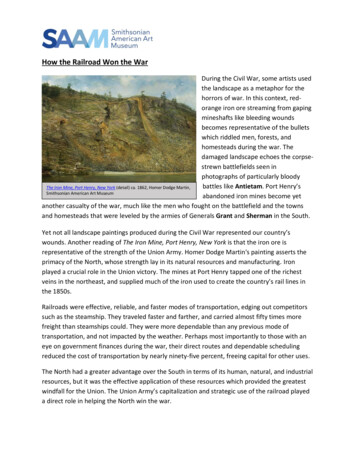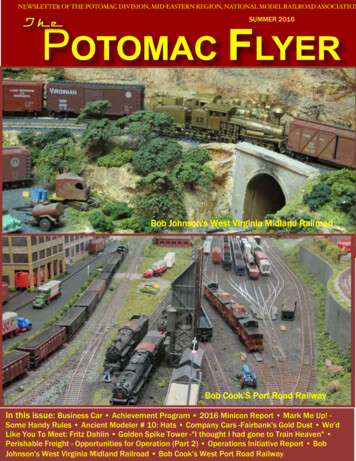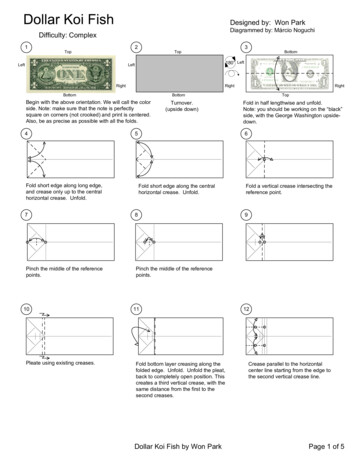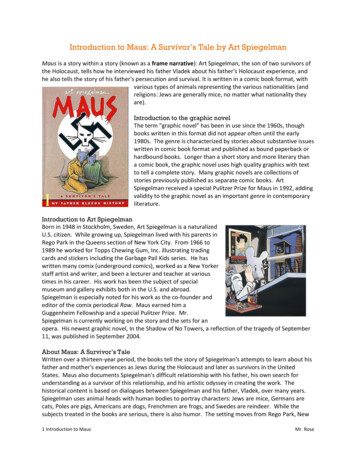
Transcription
How the Railroad Won the WarDuring the Civil War, some artists usedthe landscape as a metaphor for thehorrors of war. In this context, redorange iron ore streaming from gapingmineshafts like bleeding woundsbecomes representative of the bulletswhich riddled men, forests, andhomesteads during the war. Thedamaged landscape echoes the corpsestrewn battlefields seen inphotographs of particularly bloodybattles like Antietam. Port Henry’sThe Iron Mine, Port Henry, New York (detail) ca. 1862, Homer Dodge Martin,Smithsonian American Art Museumabandoned iron mines become yetanother casualty of the war, much like the men who fought on the battlefield and the townsand homesteads that were leveled by the armies of Generals Grant and Sherman in the South.Yet not all landscape paintings produced during the Civil War represented our country’swounds. Another reading of The Iron Mine, Port Henry, New York is that the iron ore isrepresentative of the strength of the Union Army. Homer Dodge Martin's painting asserts theprimacy of the North, whose strength lay in its natural resources and manufacturing. Ironplayed a crucial role in the Union victory. The mines at Port Henry tapped one of the richestveins in the northeast, and supplied much of the iron used to create the country’s rail lines inthe 1850s.Railroads were effective, reliable, and faster modes of transportation, edging out competitorssuch as the steamship. They traveled faster and farther, and carried almost fifty times morefreight than steamships could. They were more dependable than any previous mode oftransportation, and not impacted by the weather. Perhaps most importantly to those with aneye on government finances during the war, their direct routes and dependable schedulingreduced the cost of transportation by nearly ninety-five percent, freeing capital for other uses.The North had a greater advantage over the South in terms of its human, natural, and industrialresources, but it was the effective application of these resources which provided the greatestwindfall for the Union. The Union Army’s capitalization and strategic use of the railroad playeda direct role in helping the North win the war.
The Tactical Importance of the RailroadsThe Civil War was different from previous conflicts as it was, in a sense, the first modern war.Previous battles, like those of the Revolutionary War, had been fought in or near populousareas to take advantage of local resources. Wherea battle was fought was dependent on theavailability of these resources. Armies movedconstantly so as to not exhaust one area’s supply.But with the advent of the railroad battles nolonger needed to be waged so close to urbanareas. The majority of Civil War battles werefought outside populated areas, in what were thenremote and underdeveloped areas of the country,primarily in southern states like Mississippi,Tennessee, and Georgia. Every major Civil Warbattle east of the Mississippi River took placewithin twenty miles of a rail line. RailroadsAtlanta, Georgia, Sherman’s men destroying railroad,provided fresh supplies of arms, men, equipment,1864, George N. Barnard, Library of Congresshorses, and medical supplies on a direct route towhere armies were camped. The railroad was also put to use for medical evacuations,transporting wounded soldiers to better medical care. Consequently, armies were notdependent on the bounty, or lack thereof, of the land which they occupied.Railroads were visible symbols of industry and modernity during the Civil War. They wereagents of progress, promoters of civilization, and enhancers of democracy which could bind theNorth and the South together as one nation. They were also the lifeline of the army. A general’ssuccess or failure depended on fresh supplies and soldiers delivered directly to the battlefield.Consequently, Union strategists deliberately targeted rail junctions as campaign objectives inplaces like Chattanooga, Tennessee; Atlanta, Georgia; and Corinth, Mississippi. This wasespecially true of Atlanta, a city which served as the Confederacy’s rail hub and manufacturingcenter.Railroads became a set of guidelines between which campaigns were waged, battles werefought, and men and materials were moved. A commander’s understanding of the rail networkbecame key to managing operations and informing tactical decisions. Arguably, no Civil Warcommander used the rail network to their advantage quite like Union General WilliamTecumseh Sherman. Sherman elucidated on the importance of the railroad for the Unionduring the Atlanta campaign:
Four such groups of trains daily made one hundred and sixty cars, of ten tons each,carrying sixteen hundred tons, which exceeded the absolute necessity of the army, andallowed for the accidents that were common and inevitable. But, as I have recorded, thatsingle stem of railroad, found hundred and seventy-three miles long, supplies an army ofone hundred thousand men and thirty-five thousand animals for the period of onehundred and ninety-six days, viz., from May 1 to November 12, 1864. To have deliveredregularly that amount of food and forage by ordinary wagons would have requiredthirty-six thousand eight hundred wagons of six mules each, allowing each wagon tohave hauled two tons twenty miles each day, a simple impossibility in roads such as thenexisted in that region of country. Therefore, I reiterate that the Atlanta campaign was animpossibility without these railroads; and only then, because we had the men and meansto maintain and defend them, in addition to what were necessary to overcome theenemy.Following the Battle of Atlanta, as Sherman’sarmy moved east to begin the SavannahCampaign (commonly referred to as the Marchto the Sea), his railroad men destroyed all ofthe rail lines that led back to Chattanooga,Tennessee so as to deny a vital supply line tothe Confederates. This railway destructiontactic was referred to as Sherman’s neckties.The rails were heated and then bent into a looparound the trunks of trees, in the shape of aSoldier’s destroying the railroad, making Sherman’s neckties,December 31, 1864, Harper’s Weeklynecktie, so that they could not be easily orquickly repaired. This was such an important tactic that Sherman made it a point to oversee ithimself:The whole horizon was lurid with the bonfires of rail-ties, and groups of men all nightwere carrying the heated rails to the nearest trees, and bending them around the trunks.Colonel Poe had provided tools for ripping up the rails and twisting them when hot; butthe best and easiest way is the one I have described, of heating the middle of the ironrails on bonfires made of cross-ties, and then winding them around a telegraph-pole orthe trunk of some convenient sapling. I attached much importance to this destruction ofthe railroad, gave it my own personal attention, and made reiterated orders to others onthe subject.
Destroying the Confederacy’s railroads took away another advantage the South had over theNorth – land mass. By shrinking the vast space the Confederate Army could operate within, theUnion was able to contain the Confederate army to a much smaller, and much more vulnerable,piece of land. This cost the South its use of interior lines, crippling the ease with which they hadbeen able to move troops from point to point by railroad and attain victories.Northern versus Southern RailroadsThe South’s reliance on a primarily agrarian economy, coupled with a modest manufacturingbase, meant that there was limited demand for rail service in the Confederacy. Less capital hadbeen invested and as a result the rail network in the South was in poor condition, having beenmanufactured during the early years of railroad development when significant improvementshad not yet been made. Since manufacturing was more dominant in the North, the Union hadaccess to a disproportionate amount of foundries compared to the South.The rails of the day were made from relatively soft iron which often broke or would wear awayafter continued use. Northern foundries began to experiment with stronger and more durableiron products such as steel. But the southern foundries had difficulty purchasing the necessarysupplies for diligent upkeep of their rail lines, and as a result, the infrastructure of southern raillines gradually crumbled. It has been estimated that during the Civil War, southern foundriescould only manufacture 16,000 tons of railroad iron per year, yet 50,000 tons was required toadequately repair their deteriorating rail lines. To contrast that number, Pennsylvania foundriesalone produced almost 270,000 tons of iron in 1860. Consequently even before war broke out,the South purchased most of their iron from Northern foundries. After the war began, theSouth outsourced, purchasing iron from Europe. However, the Union navy did their best toprevent this.Southern rail lines also suffered from disconnect due to change in gauge, something that hadhappened as the rail networks evolved over time. North Carolina and Virginia shared the sametype of gauge, standard gauge, yet the rest of the Confederate rail system operated on broadgauge. This disconnect kept much of the South isolated. Freight would have to be offloaded toanother mode of transport, usually a wagon train, and then re-loaded onto another locomotive.Standardizing the gauge throughout the system during the war was not an option for the South,which lacked the time, money, and supplies to do this successfully. Once the North hadcaptured a Southern rail line, it was effectively cut off from the rest of the network andrendered useless.
GlossaryAntietam (Battle of): September 16, 1862 near Sharpsburg, Maryland, considered the bloodiestsingle-day battle in American history; the combined Union and Confederate casualtiesnumbering 22,717 persons.broad gauge: railways that use a track wider (usually 5 ft.) than the standard gauge of 4ft. 8.5in.gauge: the distance between the inner edges of the heads of the rails in a track.Grant (Ulysses S.): (1822-1885) 18th President of the United States and commanding general ofthe Union Army during the Civil War.interior lines: the military circumstance of either being able to move over a shorter distance toexecute maneuvers and effect reinforcements or possessing a more efficient transportationmethod, such as a railroad, that allows for rapid deployments.March to the Sea: military campaign waged in 1864 by General William Tecumseh Shermanwhich began with the capture of Atlanta and ended with the capture of the port city ofSavannah. It is renowned for its bold path deep into enemy territory without the use oftraditional supply lines and its level of destruction on the South. Also known as the Savannahcampaign.Savannah campaign: military campaign waged in 1864 by General William Tecumseh Shermanwhich began with the capture of Atlanta and ended with the capture of the port city ofSavannah. It is renowned for its bold path deep into enemy territory without the use oftraditional supply lines and its level of destruction on the South. Also known as the March tothe Sea.Sherman’s neckties: a railway destruction tactic developed by General William TecumsehSherman in which rails were heated and twisted into loops resembling neckties, a tactic whichrendered them unusable.standard gauge: a railway track that is 4ft. 8.5 in. wide.William Tecumseh Sherman: (1820-1891) Union army general during the Civil War, best knownfor his victory at the Battle of Shiloh, the capturing of Atlanta, and his March to the Sea.
How the Railroad Won the War During the Civil War, some artists used the landscape as a metaphor for the horrors of war. In this context, red-orange iron ore streaming from gaping mineshafts like bleeding wounds becomes representative of the bullets which riddled men, forests, and homesteads during t











